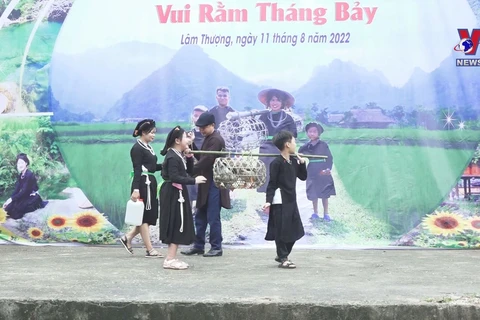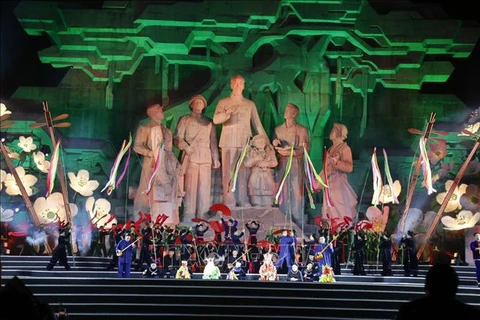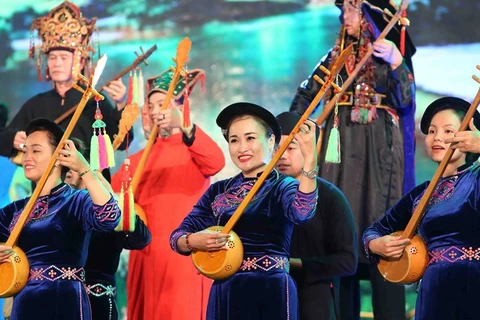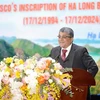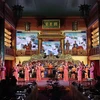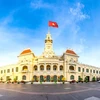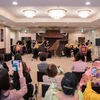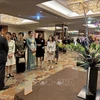Hanoi (VNA) - Sli is a unique folk singing style of the Nung ethnic minority people in Vietnam’s northern region, which is performed as a call and response between young men and women.
The singing, recognised as national intangible cultural heritage, mirrors the Nung people’s views on morality, good deeds and respect for ancestors, and has humanitarian values.
The folk genre of music is linked with activities at the Xuan Duong love market in Bac Kan province that takes place on the 25th day of the third lunar month annually.
It is a typical folk singing style of the Nung ethnic group in Bac Kan province in particular and the Viet Bac region in general, encompassing the northern provinces of Cao Bang, Bac Kan, Lang Son, Tuyen Quang and Thai Nguyen.
Sli means "poetry", a folk song in the folk art treasure of the Nung people in Lang Son. Legend has it that a fairy opened a contest to select her husband among the three men surnamed Chuong, Sinh and Ly through response singing.
The singing is often performed at festivals, markets and special events of the Nung ethnic group. Notably, the performance must focus on a topic with its wording created by singers, with a combination of facial expressions and hand gestures.
The wording and way of singing of each group may be different, but the wording is structured by "that ngon tu tuyet" (seven-lined stanza with each line composed of seven words) or "that ngon bat cu" (eight-lined poem with each line composed of seven words).
At the beginning of each performance, the two sides greet each other by saying “nhi a sloong hao” (Let’s sing), which also helps to ensure the harmony while singing.
Sli songs have rich contents, maybe visiting and congratulating someone, expressing love, faith and nostalgia when living far apart, and exchanging production experience. The most popular are Sli songs featuring love exchange which are divided into many genres and sung in different contexts.
It is a form of poem singing that expresses the flexible repartee of the singers. The love exchange Sli songs are often sung by a couple or several couples in a repartee style. Usually, a party stands out and sings first with gentle and clever greetings to invite the other party to sing together.
When this party completes greeting, the other has to quickly reply. Just like that, the two sides get caught up in the singing.
The singing has brought people closer as many singers have then become close friends or couples, while helping to educate young generations about traditions as well as respect for ancestors.
Bac Kan province now has 17 cultural heritages recognised as National Intangible Heritages.
The Nung people live together with other ethnic groups, but mostly with Tay. Therefore, the two groups have close ties and bear cultural similarities.
The Nung call the Tay Can Slua Khao (white shirt people) while the Tay call the Nung Can Slua Dam (black shirt people). The two groups are also commonly called Tho people.
The Nung grow wet rice in small and narrow valleys in the northern region, involving such work as plowing, sowing, transplanting, fertilising, weeding and watering through canals. They also grow tobacco, cotton and rice upland and raise cattle and poultry. The Nung people do some handicrafts such as weaving, cloth dyeing, forging, casting, and brick and lime making. Most families have looms for making cloth and quilts, cushions and pillows. At the age of 12, girls start to learn how to weave, and making beautiful products is a criterion of a good wife./.
The singing, recognised as national intangible cultural heritage, mirrors the Nung people’s views on morality, good deeds and respect for ancestors, and has humanitarian values.
The folk genre of music is linked with activities at the Xuan Duong love market in Bac Kan province that takes place on the 25th day of the third lunar month annually.
It is a typical folk singing style of the Nung ethnic group in Bac Kan province in particular and the Viet Bac region in general, encompassing the northern provinces of Cao Bang, Bac Kan, Lang Son, Tuyen Quang and Thai Nguyen.
Sli means "poetry", a folk song in the folk art treasure of the Nung people in Lang Son. Legend has it that a fairy opened a contest to select her husband among the three men surnamed Chuong, Sinh and Ly through response singing.
The singing is often performed at festivals, markets and special events of the Nung ethnic group. Notably, the performance must focus on a topic with its wording created by singers, with a combination of facial expressions and hand gestures.
The wording and way of singing of each group may be different, but the wording is structured by "that ngon tu tuyet" (seven-lined stanza with each line composed of seven words) or "that ngon bat cu" (eight-lined poem with each line composed of seven words).
At the beginning of each performance, the two sides greet each other by saying “nhi a sloong hao” (Let’s sing), which also helps to ensure the harmony while singing.
Sli songs have rich contents, maybe visiting and congratulating someone, expressing love, faith and nostalgia when living far apart, and exchanging production experience. The most popular are Sli songs featuring love exchange which are divided into many genres and sung in different contexts.
It is a form of poem singing that expresses the flexible repartee of the singers. The love exchange Sli songs are often sung by a couple or several couples in a repartee style. Usually, a party stands out and sings first with gentle and clever greetings to invite the other party to sing together.
When this party completes greeting, the other has to quickly reply. Just like that, the two sides get caught up in the singing.
The singing has brought people closer as many singers have then become close friends or couples, while helping to educate young generations about traditions as well as respect for ancestors.
Bac Kan province now has 17 cultural heritages recognised as National Intangible Heritages.
The Nung people live together with other ethnic groups, but mostly with Tay. Therefore, the two groups have close ties and bear cultural similarities.
The Nung call the Tay Can Slua Khao (white shirt people) while the Tay call the Nung Can Slua Dam (black shirt people). The two groups are also commonly called Tho people.
The Nung grow wet rice in small and narrow valleys in the northern region, involving such work as plowing, sowing, transplanting, fertilising, weeding and watering through canals. They also grow tobacco, cotton and rice upland and raise cattle and poultry. The Nung people do some handicrafts such as weaving, cloth dyeing, forging, casting, and brick and lime making. Most families have looms for making cloth and quilts, cushions and pillows. At the age of 12, girls start to learn how to weave, and making beautiful products is a criterion of a good wife./.
VNA

